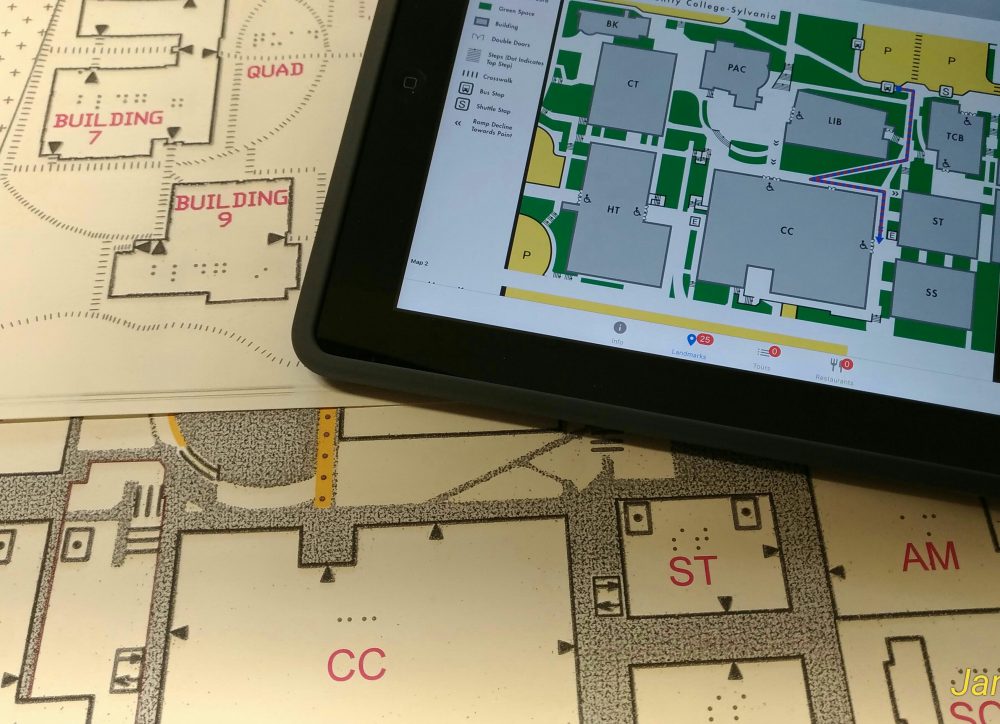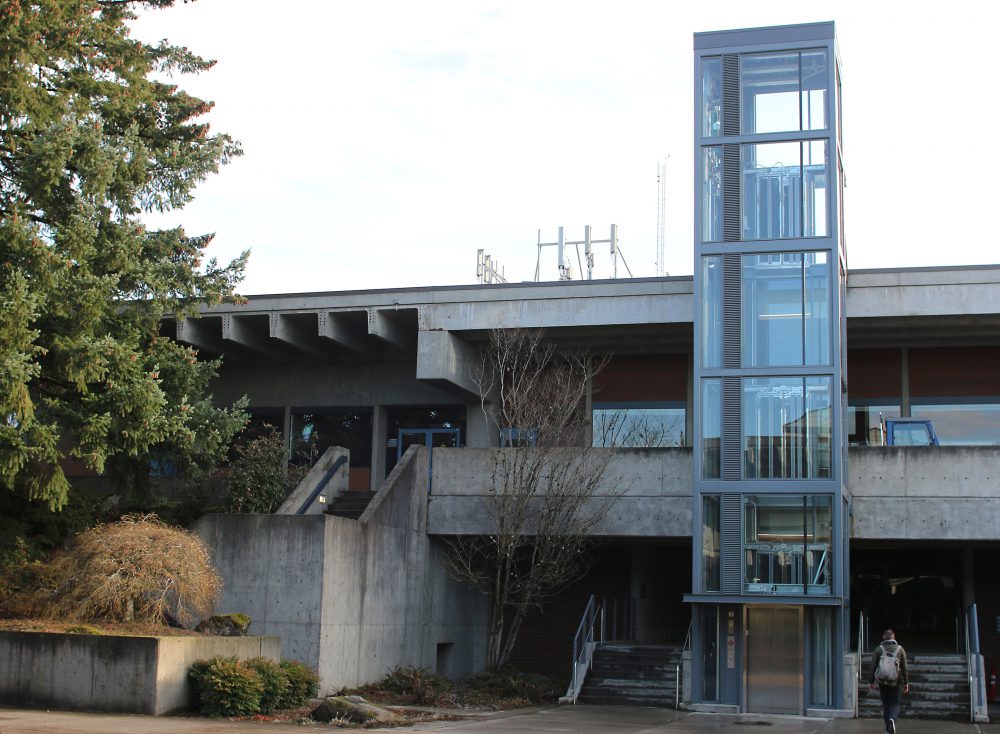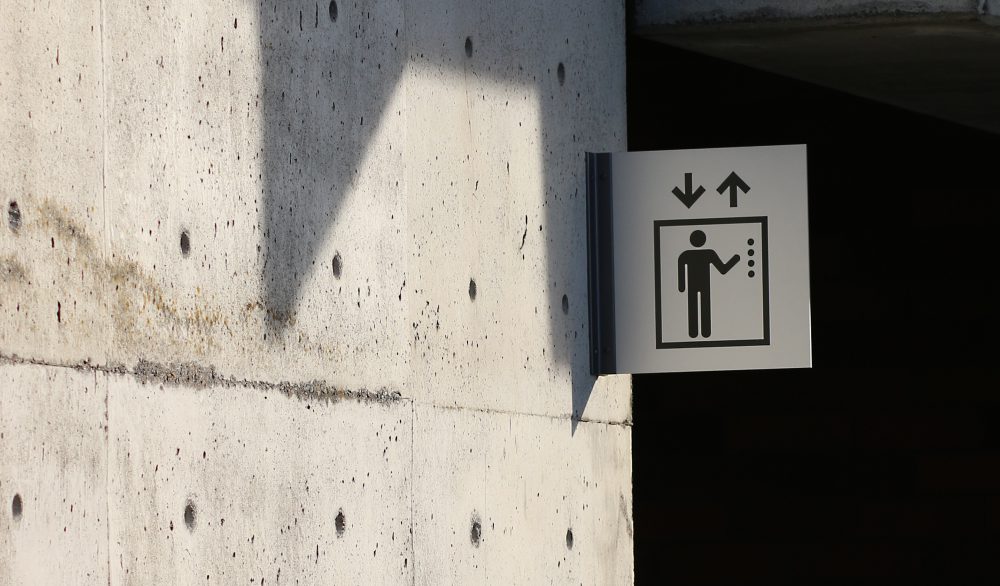This content was published: March 27, 2017. Phone numbers, email addresses, and other information may have changed.
Cool wayfinding initiatives make PCC a leader in accessibility
Photos and story by Katherine Miller

Wayfinding around PCC campuses and centers is easier for people with disabilities thanks to tactile maps with Braille and raised lines as well as low-vision maps that can be accessed on mobile devices with PCC’s Click and Go app.
Visiting a new college campus can be bewildering. Even with appropriate signage it isn’t necessarily easy to navigate to parking, the enrollment office, classrooms, restrooms and other vital services. For people with disabilities or mobility issues, things can be a lot tougher.
Adding to the challenge is that since voters approved the 2008 bond measure, Portland Community College has seen extensive construction or renovations at all four campuses and most of its centers, bringing with it temporary detours, closures and office moves.
But a collective of staff from Disability Services, Facilities Management Services (FMS) and the Web Team is creating innovative changes that have made PCC a national leader in accessibility. And like so many advances these days, the changes are digitally based.
Federal law requires the college to ensure access to its programs. But according to Kaela Parks, PCC’s director of Disability Services, there are a variety of ways to achieve that. Many schools’ websites offer static maps that show the location of accessible building features such as automatic door openers, elevators, and accessible restrooms and water fountains, she said. However, individuals who rely on assistive technology often experience barriers that require them to request an alternate format, such as tactile graphics or text-based descriptions.
“We’re trying to honor the spirit of the legal imperative to ensure access to programs as a whole by reducing the need to trigger those accommodation-related requests,” Parks said. “We do this by making sure it’s more accessible on the front end.”

Accessible features like elevators are on the online maps.
Maps Disclose Accessible Features
The solution, which is still a work in progress, lays in creating user-friendly maps of floor plans that show the accessible building features and are easily updated.
To begin, Disability Services inventoried the accessible features for all buildings at all campuses and centers. PCC Web Teamers Gabriel Nagmay and Lydia Rediske then created a plugin – software that can be used with a WordPress website – that allows PCC personnel to add placemarks to maps indicating the accessible features.
Architecture and Drafting students, who served as interns on the project, used computer-aided drafting software to generate the floor plans. The Web Team optimized the floor plans to be readable on mobile devices and uploaded the maps, after which the interns added the placemarks.
Sylvania Campus’ maps went live in December 2013, and the remaining campuses and centers were added over the following year. PCC’s Bond Program works with FMS to ensure updated floor plans are supplied to the Web Team, and Disability Services edits and adds placemarks to keep the maps current.
Now, anyone with a computer or mobile device can go to www.pcc.edu/AccessMap, choose a particular building and a floor, and receive a map that clearly indicates the location of all accessible building features, each with its own text-based description. The maps are keyboard navigable and screen-reader friendly, so the visually impaired can listen to synthesized voice directions. Tactile versions that complement the electronic maps are also available upon request.
“The bottom line is that this collaboration allowed these different groups to work together,” said Parks. “None of us could have done this alone, but together we were able to create something that had not existed before.”

For now, PCC is looking to expand the project’s utility and effectiveness, and part of that work is encouraging users to share their experiences with the maps.
Going Above and Beyond
Parks said that from the outset the team “wanted to make sure that we could do something more robust than the standard offering.”
“It’s pretty user-friendly. What’s unique about it is that this system was tested by end users throughout the entire process to ensure it’s accessible,” she said. “And that was a really important part of this whole undertaking because so often maps are not accessible to individuals who are blind or to individuals who use assistive technologies.”
Nagmay’s “Placemarks to the People” plugin presentation won “best-in-track” at the 2013 Higher Education Web Professionals Association conference, and Disability Services has presented on the project at both regional and national conferences. PCC receives regular inquiries from other colleges interested in replicating the system.
For now, PCC is looking to expand the project’s utility and effectiveness, and part of that work is encouraging users to share their experiences with the maps. A link at the bottom of the website’s accessible building features map page makes it simple to “give feedback, report barriers and suggest improvements.”
The next step is to help people navigate the connected pathways between buildings for the whole campus, rather than just interior spaces, said Parks. The college is currently testing Click and Go, a digital system that provides detailed walking directions and low-vision maps for routes between several landmarks – such as the bus stop and the College Center (CC) building. The low-vision maps are created as scalable vector graphics, which allow users to zoom in on a map from different sized devices without any loss in clarity.
After choosing a starting point and destination, users can select “Get Route Map” and walking directions will then be generated for auditory and Braille screen readers. Users can also choose to download the instructions in an MP3 or text file.
iBeacons Show the Way
Another important feature is Click and Go’s iBeacon capability, accessed through a free app that can be downloaded at iTunes. The app provides real-time auditory feedback on a mobile device as users approach key points along their route. The feedback is generated by “proximity beacons,” which use Bluetooth technology to communicate with mobile devices. The beacons are about the size of a walnut, wireless and affordable. They typically have a range of 150 to 300 feet, and strategic placement of the sensors creates a grid that has the potential to provide seamless navigation.
A limited number of beacons have been installed on key pathways at Sylvania, with the primary focus on testing the system’s ability to assist people with disabilities. Elsewhere, beacon technology is already being used to create real-time, interactive maps that show a blue dot on a mobile device as a user proceeds along a path or route, similar to a car’s navigation system. Blue dot wayfinding is already helping people navigate places such as airports, convention centers, subways, hospitals, museums and zoos.
Beacon technology can even allow an institution or company to provide relevant, location-based messages and alerts. For example, an airport’s app could notify a traveler of a last-minute gate change. At a department store, a shopper who walks into the housewares department might receive a coupon targeted to a specific product.
While PCC collects feedback from its accessible features maps and Click and Go, the Information Technology staff is exploring beacons’ broader capabilities. Some other colleges are testing them too, including Clemson University and California State University at Fresno.
“The potential is there to use beacons in a variety of ways, but the proof of concept test with Click and Go was more about navigating space, especially for people who may have mobility or vision impairments,” said Parks. “The bigger picture of beacons – especially if we were to use beacons along with a PCC app – that’s where you get the potential to do things like find the closest printing station and pay for it with your PCC print account because it’s tied to your sign-on. That’s a further stop on our journey.
“I’m all for it,” she added. “I think having a PCC app that integrates placemark-based location data with employee- or student-specific data could be enormously helpful.”
Parks stressed that any students who experience a disability can contact Disability Services at disability.services@pcc.edu and request customized help.


Please change all color-coded items on the pcc website to color over patterns so that colorblind people with spine issues (like me!) can actually read the accessibility map.
Example – All red items excluding text would be changed to have a pattern background of a jagged line.
Please add a swatch of the respective pattern background in its own field immediately before all colored text.
Example – I see a color key for the text. I am unable to identify the color. Oh, cool, this jagged line means it goes with the other jagged lines. I love PCC!
There should be a bridge between the 3rd floor of the HT building and the CC building. Getting from the third floor of HT to CC takes a really long time on crutches. I imagine it’s worse in a wheelchair. A bridge across that quad connecting the two would solve that, would improve access to the three bathrooms up there (2 outside, 1 inside HT), would improve the look of the quad, and could provide a covered walk for people walking from HT’s main floor over to the CC in the rain.
With the additional access to the bathrooms, you could then afford to turn one of them into transgendered so that there will be one on the HT side of campus.
Agree w/ Eric
There should be disabled parking spaces restored in back of the CC building to make the elevator accessible and less distance to walk to the CC, and HT buildings. There is a sidewalk that is parallel with the CC building on the south-side of the campus between the HT and CC building, there were disabled parking spaces there previously, but now they are loading zones? This provides a level access point with less distance to traverse to the CC building which is technically the center of the campus but the least accessible for disabled persons. Since Disability Services, Counseling, Financial Aid, Cafeteria, and all the student resources are in the CC building, it is imperative that access be available to the disabled students to the CC building. What about a map for the ADA/504, disabled parking?
Thank you to those who have commented. Ideas and suggestions for how to make PCC more accessible are always welcome. The ideas that have been shared here will be brought to the Accessibility Council.
Please remember too, that all PCC webpages have an accessibility link in the footer so feedback can be shared at any time. Additionally, students can access individualized supports through Disability Services; employees or members of the community can work with me, PCC’s ADA Coordinator.
Contact Disability Services by email at disability.services@pcc.edu, phone 971-722-4341 or video phone: 503-928-5875.
Contact the ADA Coordinator at adacoordinator@pcc.edu or 971-722-5851.
We also need better and more visible signage on the sides of all the buildings. Is this in anyone’s plans?
Eric,
A bridge is a great idea. This was brought up at a recent meeting for the remodel of the HT Building. This is on the wish list and will be given more consideration as plans progress. As with everything, this is dependent on funding. Thank you for your suggestions.